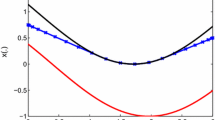Abstract
The inverse shortest paths problem in a graph is considered, that is, the problem of recovering the arc costs given some information about the shortest paths in the graph. The problem is first motivated by some practical examples arising from applications. An algorithm based on the Goldfarb-Idnani method for convex quadratic programming is then proposed and analyzed for one of the instances of the problem. Preliminary numerical results are reported.
Similar content being viewed by others
References
P.H. Calamai and A.R. Conn, “A stable algorithm for solving the multifacility location problem involving Euclidian distances,”SIAM Journal on Scientific and Statistical Computing 4 (1980) 512–525.
P.H. Calamai and A.R. Conn, “A second-order method for solving the continuous multifacility location problem,” in: G.A. Watson, ed.,Numerical Analysis: Proceedings of the Ninth Biennial Conference, Dundee, Scotland. Lectures Notes in Mathematics No 912 (Springer, Berlin-Heidelberg-New York, 1982) pp 1–25.
P.H. Calamai and A.R. Conn, “A projected Newton method forl p norm location problem,”Mathematical Programming 38 (1987) 75–109.
E.W. Dijkstra, “A note on two problems in connexion with graphs,”Numerische Mathematik 1 (1959) 269–271.
D.B. Johnson, “Efficient algorithms for shortest paths in sparse networks,”Journal of the Assocation for Computing Machinery 24 (1977) 1–13.
J.A. George and J.W. Liu,Computer Solution of Large Positive Definite Systems (Prentice-Hall, Englewood Cliffs, N.J. 1981).
D. Goldfarb and A. Idnani, “A numerically stable dual method for solving strictly convex quadratic programs,”Mathematical Programming 27 (1983) 1–33.
G.H. Golub and C.F. van Loan,Matrix Computations (North Oxford Academic, Oxford, 1983).
G. Neumann-Denzau and J. Behrens, “Inversion of seismic data using tomographical reconstruction techniques for investigations of laterally inhomogeneous media,”Geophysical Journal of the Royal Astronomical Society 79 (1984) 305–315.
G. Nolet, ed.,Seismic Tomography (Reidel, Dordrecht, 1987).
M.J.D. Powell, “On the quadratic programming algorithm of Goldfarb and Idnani,”Mathematical Programming Study 25 (1985) 45–61.
M.J.D. Powell, “ZQPCVX, A Fortran subroutine for convex quadratic programming,” Report DAMTP/NA17, Department of Applied Mathematics and Theoretical Physics, University of Cambridge (Cambridge, UK, 1983).
A. Tarantola,Inverse Problem Theory. Methods for Data Fitting and Model Parameter Estimation (Elsevier, Amsterdam, 1987).
R.E. Tarjan, “Data structures and network algorithms,”CBMS-BSF Conference Series in Applied Mathematics (SIAM, Philadelphia, PA, 1983).
J.H. Woodhouse and A.M. Dziewonski, “Mapping the upper mantle: three-dimensional modeling of Earth structure by inversion of seismic waveforms,”Journal of Geophysical Research 89 (B7) (1984) 5953–5986.
Author information
Authors and Affiliations
Rights and permissions
About this article
Cite this article
Burton, D., Toint, P.L. On an instance of the inverse shortest paths problem. Mathematical Programming 53, 45–61 (1992). https://doi.org/10.1007/BF01585693
Received:
Revised:
Issue Date:
DOI: https://doi.org/10.1007/BF01585693




